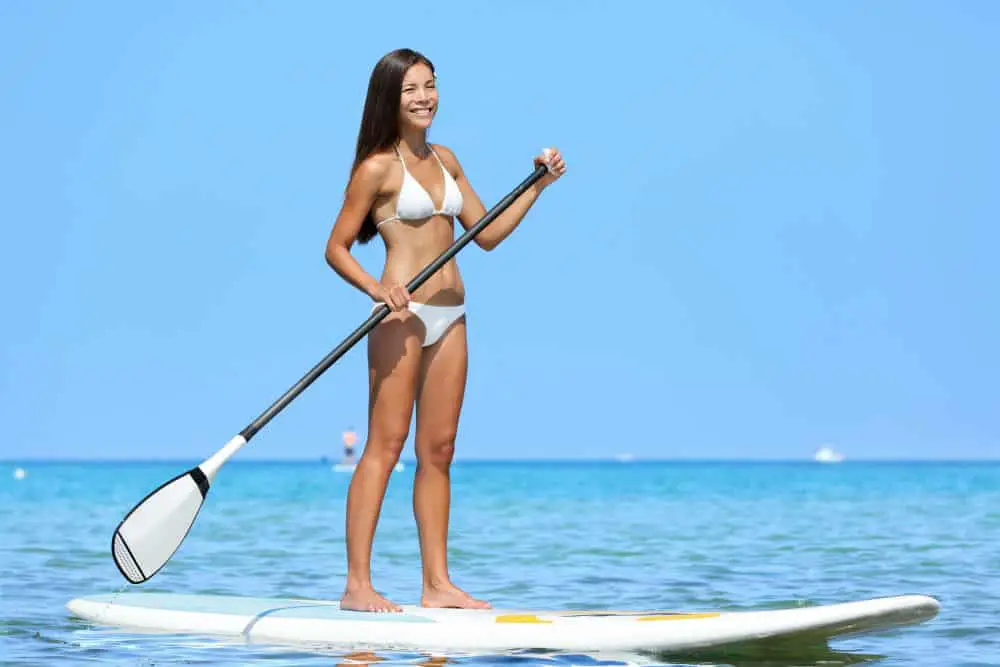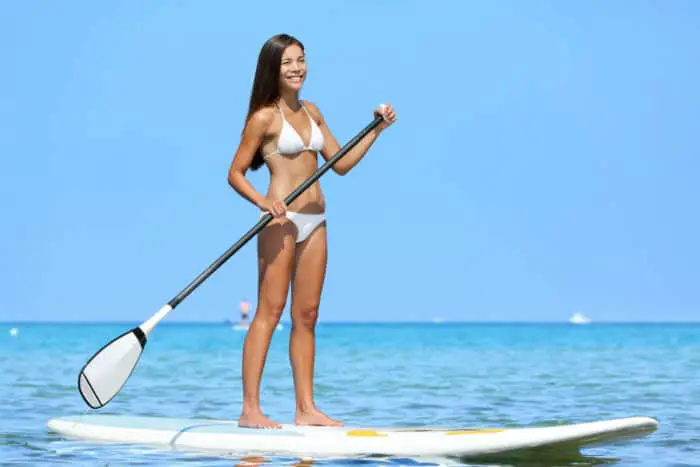As an Amazon Associate we earn from qualifying purchases.

Stand-up paddleboarding (SUP, for short) has recently gained a lot of popularity. But why is that? Well, it is relatively easy to get into it. You just have to train your balance, but on calm waters that’s not too hard at all.
You can invite friends and family so everyone can try it. You can take your dog with you if you like. You can even practice yoga on a paddleboard.
Even though it may seem like a relaxing activity, it’s also quite a workout. And you get to stand on top of the water, which can make for quite a view.
If you’ve been meaning to get into SUP, you may be wondering, “Which stand-up paddleboard should I buy?” We’re here to give you some tips so you can choose for yourself.
Table of Contents
Paddleboard shape
Paddleboards come in many shapes and sizes. All this can be a bit overwhelming so let’s try to clarify it for you. There are several types of paddleboards according to their shape.
They can be divided into two main groups: planing hull and displacement boards.
Planing hull paddleboards
Planing hull boards are generally flat and wide, and their tip is also wide and round. They are designed mainly for maneuverability, but due to the wider body, it is easier for you to keep your balance.
So, if you are a beginner, this is probably the type of stand-up paddleboard you should buy.
Surfing
Surfing paddleboards are shorter than other boards, and excel at quick turns. Obviously, they are the best for riding waves. They are not as stable as some of the larger boards, and it can be difficult to stay the course, making them a poor choice for long journeys. As the name indicates, this is the stand-up paddleboard you should buy for surfing.
Yoga
Yoga paddleboards are a bit longer than surf ones, and also wider. Their focus is balance and stability, and they usually come with soft tops.
All this is so that you can practice yoga more comfortably. Some boards also include places to attach yoga exercise tools and anchoring accessories.
All-rounder
This is the most versatile type of paddleboard, and can handle most conditions well. They are long like displacement boards and easy to keep on a track, yet provide some maneuverability. They also have reasonable width, which provides great stability. This is an excellent choice for a beginner.
Displacement hull paddleboards
Displacement hull paddleboards are designed to displace water, hence the name. They are long and have a sharp, pointy tip to cut through the surface of the water for more speed. However, they are not as stable as planing hull boards.
Touring
Touring boards are one of the most popular types of board. One of the reasons for this is that they are also quite stable, making it another good choice for beginners.
Their shape is best suited for long rides in still water, where they can easily glide through the surface.
Racing
Racing boards are designed mostly for speed. They are usually made of the lightest-weight exotic materials, making them generally more expensive than others.
Their pointy tips are great for cutting through the water at great pace, but they can also be challenging to balance, especially at lower speeds.
Paddleboard construction types
There are essentially two types of paddleboards, as far as construction is concerned. When asking yourself which stand-up paddleboard you should buy, you should also consider whether to get a solid board or an inflatable one.
Both types of boards can include several materials in their construction. Plastic and foam are generally the cheapest, and carbon fiber is the most expensive, with fiberglass (epoxy) somewhere in between.
Being more expensive doesn’t automatically make a paddleboard suitable for all situations. For example, carbon fiber might not be an adequate material for whitewater, as it may get damaged.
A foam board can take some dents without loss of performance, and it won’t affect your budget too much.
Now that we’ve covered the materials, let’s take a look at some advantages and disadvantages of solid and inflatable paddleboards.
Solid
Solid paddleboards can have several different compositions, as we’ve already seen. Sometimes they may have a core and outer layer made of different materials, like a foam core with a fiberglass coating.
They may also include some wooden panels on top that make for really nice finishes. Solid paddleboards are great for:
- Due to their rigidity and weight, solid boards are usually more stable
- These boards have more contact with the water and glide more easily on its surface
- When answering the question, “which stand-up paddleboard should I buy?”, you may want to choose a size that fits you perfectly. This is more likely to happen with solid boards which come in more varieties
Inflatable
Inflatable paddleboards usually have PVC exteriors and are connected by interwoven fibers within. Being composed mainly of air, they are quite lightweight, but you would be surprised by their rigidity once inflated. Advantages of inflatable boards include:
- Easy to carry. Since you can deflate inflatable boards when not in use, they are much more compact and lightweight, making them the ideal travel companions. They are much easier to store for the same reason
- Appropriate for whitewater. Inflatable boards can handle bumps against rocks much better than most of the solid ones
- They are easier on your budget than solid boards
Paddleboard size
When thinking about which stand-up paddleboard you should buy, volume, length, and width are important aspects to consider.
Length
You should choose the length and width of your board before considering the volume. Generally speaking, there are three sizes of boards: short (10′ and below), medium (between 10′ and 12′) and long (12′ and above).
Short paddleboards are the best for children, and also for surfing. Medium-length boards are generally all-rounders and yoga SUPs. Long boards are typically displacement hull boards, although some touring boards may fit into the medium size category.
Width
The width of a paddleboard will determine its stability. So consider your current skill level when asking yourself which stand-up paddleboard you should buy.
However, the size of the person is also important. You should be able to easily reach both sides of the board for comfortable paddling. Also, wider boards are better if you’re looking to carry items with you or want to practice yoga.
Volume/weight capacity
The volume and weight capacity of a board will generally determine how much weight it can handle. If you are a beginner, and especially if you’re considering a planing hull board, these specifications are not very important, as long as you’re below the maximum rated weight.
However, for displacement hull boards, the volume and weight capacity must be really well balanced in order not to affect the board’s performance.
Amazon and the Amazon logo are trademarks of Amazon.com, Inc, or its affiliates.

